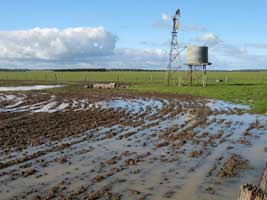Waterlogging
|
What is it? |  Photograph of an area of waterlogged soil in a flat landscape with free water building-up on the soil surface |
Impact
Waterlogging restricts aeration and gas exchange and thus causes a shut down in many ecosystem functions of soil. Respiration and plant growth are reduced and the plant may die if the waterlogging persists. Vegetation will change over time as plants tolerant to waterlogging gain an advantage.
Saturated soils loose strength and hence tractability is lost and the soil is highly susceptible to pugging.
Management
If the waterlogged area is not a natural wetland (there are legislative requirements for the protection of wetlands) and the waterlogging has been induced, the primary requirement is to improve soil internal drainage. This will involve modification of restricting layers (probably compacted zones) in the soil profile to increase porosity and permeability.
Victorian Information
Further information on waterlogging can be found on the soil health site.
Related Links
Information Note AG0956: Managing wet soils: what are your best options?


